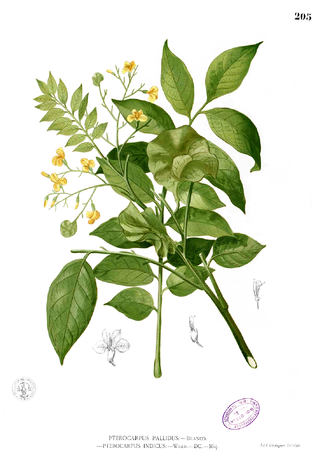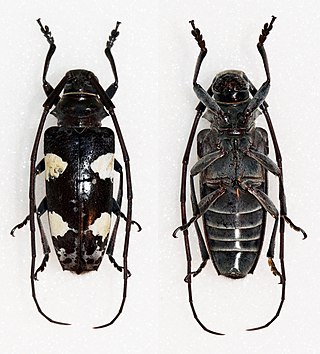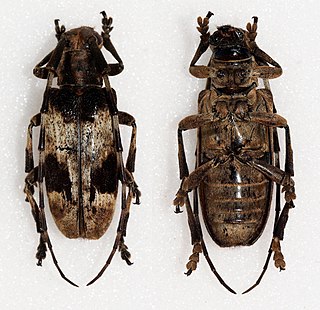The zebu, sometimes known in the plural as indicine cattle, Camel cow or humped cattle, is a species or subspecies of domestic cattle originating in South Asia. Zebu, like many Sanga cattle breeds, differs from taurine cattle by a fatty hump on their shoulders, a large dewlap, and sometimes drooping ears. They are well adapted to withstanding high temperatures and are farmed throughout the tropics.

The red-wattled lapwing is an Asian lapwing or large plover, a wader in the family Charadriidae. Like other lapwings they are ground birds that are incapable of perching. Their characteristic loud alarm calls are indicators of human or animal movements and the sounds have been variously rendered as did he do it or pity to do it leading to the colloquial name of did-he-do-it bird. Usually seen in pairs or small groups not far from water, they sometimes form large aggregations in the non-breeding season (winter). They nest in a ground scrape laying three to four camouflaged eggs. Adults near the nest fly around, diving at potential predators while calling noisily. The cryptically patterned chicks hatch and immediately follow their parents to feed, hiding by lying low on the ground or in the grass when threatened.

The Indian prawn is one of the major commercial prawn species of the world. It is found in the Indo-West Pacific from eastern and south-eastern Africa, through India, Malaysia and Indonesia to southern China and northern Australia. Adult shrimp grow to a length of about 22 cm (9 in) and live on the seabed to depths of about 90 m (300 ft). The early developmental stages take place in the sea before the larvae move into estuaries. They return to the sea as sub-adults.

The Malayan tapir, also called Asian tapir, Asiatic tapir, oriental tapir, Indian tapir, piebald tapir, or black-and-white tapir, is the only living tapir species outside of the Americas. It is native to Southeast Asia from the Malay Peninsula to Sumatra. It has been listed as Endangered on the IUCN Red List since 2008, as the population is estimated to comprise fewer than 2,500 mature individuals.

Pterocarpus indicus is a species of Pterocarpus native to southeastern Asia, northern Australasia, and the western Pacific Ocean islands, in Cambodia, southernmost China, East Timor, Indonesia, Malaysia, Papua New Guinea, the Philippines, the Ryukyu Islands, the Solomon Islands, Thailand, and Vietnam.

Titanosaurus is a dubious genus of sauropod dinosaurs, first described by Richard Lydekker in 1877. It is known from the Maastrichtian Lameta Formation of India.

The mangrove monitor, mangrove goanna, or Western Pacific monitor lizard is a member of the monitor lizard family with a large distribution from northern Australia and New Guinea to the Moluccas and Solomon Islands. It grows to lengths of 3.5 to 4 ft. It is also known as wbl yb in the Kalam language of Papua New Guinea.

The smallbelly catshark is a catshark of the family Scyliorhinidae found in the western Indian Ocean near Somalia, the Gulf of Aden, and Oman, at depths between 1,300 and 1,840 m. Its length is up to 34 cm, although this measurement is of an immature specimen. The smallbelly catshark is not well known. It is found on continental slopes, and is probably caught by bottom trawlers. The reproduction of the smallbelly catshark is oviparous.
Mucor indicus is among the most important members of zygomycetes fungi. This dimorphic fungus is capable of production of several valuable products. Some strains of the fungus have been isolated from the traditional Indonesian food tempeh. M. indicus is nowadays used for production of several homemade food and beverages especially in Asia. This has also been successfully used as a safe nutritional source for fish and rat. The fungus is generally regarded as safe though there are few reports claiming that this is a pathogenic fungus.

Blepephaeus is a genus of longhorn beetles of the subfamily Lamiinae, containing the following species:
Blepephaeus andamanicus is a species of beetle in the family Cerambycidae. It was described by Stephan von Breuning in 1935. It is known from the Andaman Islands.
Blepephaeus lemoulti is a species of beetle in the family Cerambycidae. It was described by Stephan von Breuning in 1938. It is known from Laos.
Blepephaeus higaononi is a species of beetle in the family Cerambycidae. It was described by Vives in 2009. It is known from the Philippines.

Blepephaeus irregularis is a species of beetle in the family Cerambycidae. It was described by Heller in 1915. It is known from the Philippines. It contains the varietas Blepephaeus irregularis var. alboreductus.
Blepephaeus puae is a species of beetle in the family Cerambycidae. It was described by Lin in 2011. It is known from China.

Blepephaeus succinctor is a species of beetle in the family Cerambycidae. It was described by Louis Alexandre Auguste Chevrolat in 1852, originally under the genus Monohammus. It is known from Malaysia, India, Sumatra, Myanmar, Taiwan, China, Thailand, and Vietnam. It feeds on Acacia confusa, Albizia chinensis, Firmiana simplex, Melia azedarach, Morus alba, and Vernicia fordii.
Blepephaeus undulatus is a species of beetle in the family Cerambycidae. It was described by Maurice Pic in 1930.









